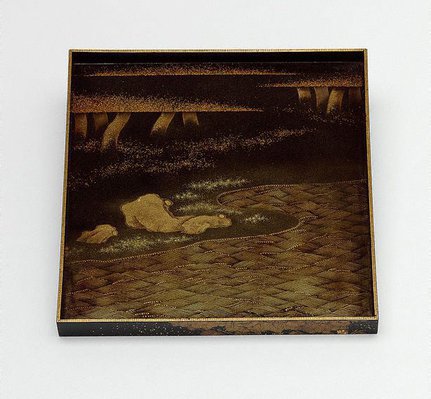-
Details
- Place where the work was made
-
Japan
- Period
- Edo (Tokugawa) period 1615 - 1868 → Japan
- Date
- 18th century-19th century
- Media category
- Lacquerware
- Materials used
- lacquer
- Dimensions
- 18.3 x 16.8 x 3.0 cm
- Signature & date
Not signed. Not dated.
- Credit
- Purchased 2004
- Location
- Not on display
- Accession number
- 257.2004
- Copyright
- Share
-
-
About
This elegant lacquer box is a 'suzuribako', designed to contain the inkstone, water dropper and brushes needed for Japanese calligraphy. The instruments of writing and painting have always been treasured in China and Japan, with much artistry exercised in the production of top quality pieces like this one.
Although the use of decorative lacquer was developed in China, in Japan it reached an outstanding level of technical and artistic quality and ranks among the most distinctive achievements of traditional Japanese crafts. This piece is unsigned but is of very high quality and epitomises the refined sumptuousness favoured by the discerning and wealthy Edo period patron.
The design is striking but understated, with a masterfully arranged composition of gold pine trees wrapping around the edges of the lid and the exterior of the base and continuing onto the inside of the box, where the pine tree motif is set off by a scene of a rocky shore and gently rolling waves. The theme of pines and rocky shores undoubtedly refers to Matsushima, one of Japan's famous beauty spots. Continuing the waterside theme, the matching silver water dropper is in the shape of a shell.
The box incorporates a variety of representative lacquerware techniques, with a background of rich 'roiro' (a particularly deep and high gloss black lacquer) providing a dramatic backdrop to the design of gold pine trees executed mainly in the sophisticated 'togidashi' technique, where the design is covered and the hardened surface polished until the design reappears.
The 'suzuribako' dislays a variety of representative lacquerware techniques:
'Togidashi': where the design is covered and the hardened surface is polished until the design reappears
'Kirikane': where pieces of metallic foil are applied to the lacquer
'Nashiji': where fine gold flakes are sunk into a wet orange lacquer surface to create a background resembling ‘pear skin’
'Obihirame': a mosaic of relatively large, irregular-shaped metallic pieces
'Hiramakie': low relief ‘sprinkled picture’ lacquer, where motifs are drawn in lacquer and metal filings are sprinkled on before the lacquer has driedAsian Art Department, AGNSW, October 2004.
-
Places
Where the work was made
Japan
-
Exhibition history
Shown in 1 exhibition
Beyond Words: Calligraphic Traditions of Asia, Art Gallery of New South Wales, Sydney, 27 Aug 2016–30 Apr 2017
-
Bibliography
Referenced in 1 publication
-
Clare Pollard, Look, 'A remarkable marriage', pg. 21, Sydney, Jun 2005, 21 (colour illus.).
-

